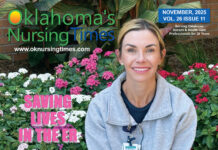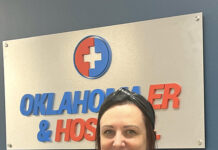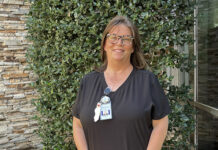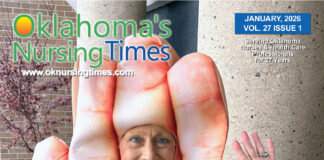Human trafficking is a serious problem across the United States, but health care professionals may be in a position to identify and help its victims.
The Fran and Earl Ziegler College of Nursing at the University of Oklahoma Health Sciences Center is holding a discussion, “The Health Professional’s Role When Faced With Human Trafficking,” on Friday, Sept. 29. Registered nurse Karen Peters, an assistant professor in the College of Nursing, will speak on the topic, along with representatives from the Oklahoma Bureau of Narcotics and The Dragonfly Home, a program in Oklahoma City that helps those who have survived human trafficking.
Below, Peters answers questions about the role of the health care professional in helping victims of human trafficking.
Q: Why is it important to educate both health care students and health care professionals about human trafficking?
Peters: Human trafficking is an unimaginable abuse of human rights that shatters people both physically and psychologically, as it undermines the health and safety of all communities it touches. Of the millions of people trapped within this lucrative business throughout the world, up to 50 percent end up somewhere within the health care system seeking care for illnesses or injuries sustained while in captivity. Tragically, the majority of these individuals are not recognized as victims of trafficking and therefore do not receive appropriate interventions to help them escape and reintegrate back into society. Because human trafficking has been identified in cities, towns and rural communities in all 50 states, it is imperative that health care professionals and any person seeking a career in health care equip themselves with knowledge on how human trafficking presents, be prepared to intervene when victims/survivors are identified, and work collaboratively with other agencies to protect them from further harm.
Q: In what settings would health professionals be likely to intervene?
Peters: Nurses, in particular emergency department nurses, are often frontline caregivers to these patients; therefore; it is crucial that they have appropriate training to help identify and assist potential victims. However, health care professionals in other settings need this training as well. Trafficked individuals have been found seeking care in urgent care and OBGYN clinics, health departments, dentist and physician offices and free clinics. Because the brutal nature of this business leaves many of these individuals with life-threatening illnesses or injuries, our ambulance services, including paramedics and EMTs, also need training.
Q: What can nurses and other health care professionals do to notice the signs of human trafficking?
Peters: According to the U.S. Department of Labor, more than 12 million people are employed in health care occupations – that’s almost 10 percent of the national workforce. Imagine the possibilities if these professionals received training on human trafficking. From the emergency responder to the triage nurse to the dentist to the social worker … every member of a health care facility has opportunities to identify and assist victims of trafficking. Training is the key. Health care professionals must have in-depth knowledge of human trafficking and its impact on the individual’s overall health; they must be skilled in identifying “red flags” that might indicate an individual is a trafficker or a victim; they must be skilled in providing appropriate interventions and trauma-informed care; and they must work collaboratively with other agencies and know what resources are available.
Q: What are some of those signs or “red flag” indicators?
Peters: First of all, it may be very difficult to recognize traffickers. They don’t fit the common perceptions that most people have. They are rarely those “creepy-looking characters” lurking in the shadows. Traffickers often present themselves as handsome boyfriends, representatives of employment agencies, parents or other close family members. They come from different social backgrounds, are of different nationalities and age, and can be women as much as men. Therefore, you must look for those “red flags,” and consider: Is this person continuously monitoring and controlling the patient? Or is there evidence of censored communication?
Potential victims are also difficult to recognize. They don’t speak a particular language; they are of no particular age, race or cultural background; and although the majority of those trafficked are women and children, they can look like anyone. Rarely will they openly identify themselves, so it’s crucial for health care professionals to detect the nonverbal cues and physical signs. A key to recognition is an understanding of stress and trauma and how it affects individuals who are trafficked. With this in mind, some behavioral indicators include:
* Gaps in memory, such as providing a disjointed timeline of events with inconsistencies or changing details.
* Showing high levels of fear and anxiety for service providers and law enforcement while expressing loyalty and gratitude toward the accompanying “controlling” individual.
There are also physical signs that indicate evidence of a general lack of health care, such as malnutrition, serious dental problems and poorly or untreated injuries or illnesses. With sex trafficking, the individual may present with evidence of frequent or untreated sexually transmitted infections. There also may be evidence of frequent abortions or miscarriages. A common finding throughout the United States is branding or tattooing. This permanent marking labels the individual as the trafficker’s property and helps him/her advertise to buyers who may be looking for a specific type of “product.” It also lets the individual know that the trafficker is in control and the relationship is permanent.
Q: What should a health care professional do if he/she suspects a patient is caught in a trafficking situation?
Peters: The health care professional must be aware of the following:
* If you think someone’s life or safety is in immediate danger, call 911.
* If the victim/survivor is a minor and there are suspicions of trafficking, the health care professional is under legal obligation to phone child protective services. Mandatory reporting laws must be followed at all times.
* If the victim/survivor is an adult, the health care professional cannot force him/her to report the crime or receive help. Remember, the individual and his/her family may be at risk for immense harm if reporting occurs. With this in mind, the health care professional must provide an environment that offers the individual every opportunity to receive help. The health care professional and the victim/survivor are encouraged to call the National Human Trafficking Resource Center for resources and guidance. The number is 1-888-373-7878. You can reach them 24 hours per day, seven days a week, and more than 200 language translations are available.
* Finally, if you have suspicions that you think need to be investigated, please contact the Oklahoma Bureau of Narcotics Human Trafficking toll free hotline at 1-855-617-2288.













